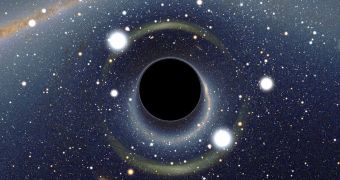Albert Einstein's theory on how the Universe operates, and on how its components interact, is put to the test in a new scientific study. Experts want to apply the famed physicist's principle to one of the most brutal and mysterious events in the Cosmos, the collision of two black holes.
The Theory on General Relativity was published less than a century ago, and physicists have been trying out new ways of testing it ever since. Thus far, all experiments have confirmed Einstein's work.
But now investigators want to determine whether the predictions the physicist made hold true around colliding black holes or not. These events were selected because they represent the most extreme circumstances depicted in the theory.
Einstein's main contribution to science was presenting the Universe as a layer of fabric on a bed. This fabric is the space-time continuum, which is distorted by the force of gravity. A star or a black hole in space acts just like a heavy metal ball placed on sheet of fabric – it creates a dimple.
This warping of space and time is believed to be most intense around the heaviest and most dense objects in the Cosmos. As such, black holes have the largest potential to put dents in Einstein's theory.
If his equations hold at the event horizons of interacting black holes, then the chances of them failing anywhere else are zero. Testing the theory in such conditions is only possible due to the development of new and advanced mathematical models and observations technologies.
“You always want to test your theories in the most extreme situations possible,” explains New York University cosmologist and particle physicist Michael Kesden, the leader of the new investigation.
“We believe that some galaxies form by two smaller galaxies colliding. The supermassive black holes at their center are also colliding,” he adds. As this happens, massive streams of radiation are produced.
“The gravitational waves emitted by such systems are the strongest known in the Universe,” explains Northwestern University astrophysicist and gravitational wave specialist Vicky Kalogera.
While testing gravity is the main objective of relativity studies, detecting gravity is possible only through analyzing gravitational waves, experts continue.
As new technologies and detectors are produced, the number of studies related to testing Albert Einstein's 95-year-old theory is expected to increase considerably.
They will help astrophysicists learn how the Universe is set up, and allow us to learn a lot more about gravity and black holes in the process.

 14 DAY TRIAL //
14 DAY TRIAL //